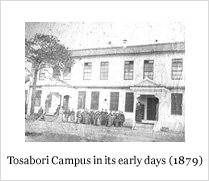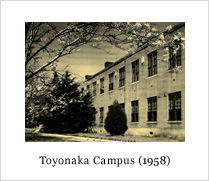Home » Educational Philosophy » History
The founder of Baika Women's University, Bouro (Paul) Sawayama, dedicated his entire life to women's education as he was engaged in missionary activities as a pastor. In 1878, he founded the predecessor of the university, Baika Girls' School. Rev. Sawayama's personal ideals of "fostering loving people" were upheld by many supporters, the church, teachers and students. These people were all united as "one mind" during the school's early days to pioneer higher education for women in Japan.

With Christianity-based education as the founding philosophy, Rev. Paul Sawayama opened Baika Girls' School at Tosabori Uramachi 10-banchi in Osaka City (now southwest of the Higobashi intersection) by receiving support from Jinzo Naruse, a cooperating pastor, and volunteer believers. Unlike a conventional mission school run by foreign missionaries, it became Japan's first self-sustaining school operated by a Japanese-run church with expenses borne by students. To establish the school, he needed the support of members of the Naniwa Kokai church that he established in 1877 and its mother church, Umehonmachi Kokai (now Osaka Church). In appreciation of their assistance, Rev. Sawayama named his school "Baika" by taking a Japanese kanji character from the name of each of the supporting churches. This is where Baika Gakuen's history began.

In response to the growing number of students, the Baika Girls' School moved from Tosabori to the Kitano district (now Toyosaki 3-chome, Kita-ku, Osaka). The newly built school building had a red roof with cream-colored walls, exhibiting a modern look for that time.
As stipulated by the Girls' High School Ordinance, a new four-year Baika Girls' High School was established within the Kitano Campus. In the following year (1914), the Baika Girls' School initiated a fresh start as Baika Girls' School's two-year professional education departments (Department of English Literature and Department of Home Economics). These departments required a high school graduation certificate or equivalent academic qualification for admission.
Under the Professional School Ordinance, the Baika Girls' School's Departments of English Literature and Home Economics were promoted to become the first professional school for women in Osaka, called the Baika Women's Professional School. Then in 1926, the Department of Japanese Literature was set up. Along with this, by extending the course term to five years, the Baika Girls' High School had developed steadily as a higher education institution for women in Osaka.

To accommodate a significantly increased number of students at the girls' high school and the women's professional school, the Baika campus was moved to Toyonakamura, Toyono-gun, Osaka Prefecture (now Ueno Nishi 1-chome, Toyonaka).

Due to Japan's education system reform, the Baika Girls' High School was separated into Baika Junior High School and Baika High School. In the same year, Baika Women's Professional School was chartered as Baika Junior College. Initially, the Baika Junior College only included the Department of English, but the Department of Home Economics was added later in 1959.

In this year, Baika Women's University was opened at Shukunosho, Ibaraki City (Department of Japanese Literature and Department of English and American Literature in Faculty of Letters). In 1977, the Graduate School of Letters (Division of Japanese Literature and Division of English and American Literature) was set up.




